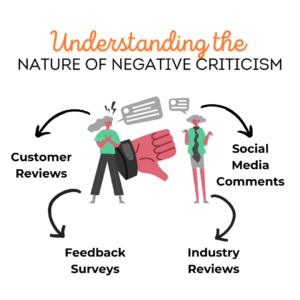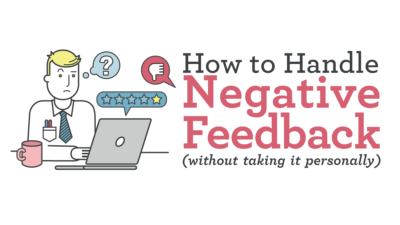In the world of digital marketing, feedback comes in many forms, from glowing reviews to harsh criticisms. While positive feedback is easy to embrace, negative criticism can often feel like a thorn in your side. However, handling negative criticism effectively can be a powerful tool for growth and improvement. It can transform your brand’s reputation, enhance your products or services, and ultimately lead to better customer satisfaction. In this article, we’ll explore the ins and outs of dealing with negative criticism in digital marketing and provide actionable tips and strategies to turn potential setbacks into stepping stones for success.
Understanding the Nature of Negative Criticism

Before diving into strategies for handling negative criticism, it’s crucial to understand what it truly represents. Negative criticism in digital marketing can come from various sources:
- Customer Reviews: Negative reviews on platforms like Google, Yelp, or Trustpilot.
- Social Media Comments: Critical comments on platforms such as Facebook, Instagram, or Twitter.
- Feedback Surveys: Direct feedback through customer surveys and feedback forms.
- Industry Reviews: Critiques from industry experts or competitors.
Why Negative Criticism Matters

Negative criticism can be unsettling, but it serves several essential functions:
- Provides Insight: Negative feedback often highlights areas where your product or service may be falling short.
- Opens Communication: It provides an opportunity to engage with customers and demonstrate your commitment to their satisfaction.
- Drives Improvement: Constructive criticism can act as a catalyst for refining your offerings and enhancing customer experience.
Understanding these functions can help shift your perspective from viewing criticism as a threat to recognizing it as an opportunity.
The Psychological Impact of Negative Criticism
Negative criticism can have a profound psychological impact on businesses and marketers. It’s natural to feel defensive or discouraged when faced with harsh words. Here are some common reactions:
- Defensiveness: The immediate reaction is often to defend your brand or dismiss the criticism.
- Disheartenment: Negative feedback can affect morale and lead to self-doubt.
- Fear of Damage: Concerns about the potential damage to your brand’s reputation and business impact.
However, it’s important to recognize these reactions and understand that they are part of the process. Acknowledging these feelings allows you to move beyond them and focus on constructive action.
Tips and Strategies for Handling Negative Criticism
Now that we understand the nature and impact of negative criticism, let’s explore some practical tips and strategies to handle it effectively.

1. Listen and Acknowledge
Listen Carefully: Pay close attention to the criticism without interrupting or dismissing it. This shows respect for the customer’s perspective and can provide valuable insights.
Acknowledge the Issue: Begin by acknowledging the customer’s feelings and concerns. Use empathetic language to demonstrate understanding. For example, “We understand your frustration, and we’re sorry to hear about your experience.”
2. Respond Promptly and Professionally
Timely Response: Aim to respond to negative feedback as soon as possible. A quick response shows that you value the customer’s input and are eager to resolve the issue.
Stay Professional: Keep your tone professional and courteous, even if the criticism is harsh or unfair. Avoid becoming defensive or engaging in arguments. Maintain composure to show that your brand is committed to customer satisfaction.
3. Take the Conversation Offline
Personalized Approach: For complex issues, consider taking the conversation offline. Invite the customer to reach out via email or phone, allowing for a more personalized and in-depth resolution.
Provide Contact Information: Share contact details where they can directly communicate with your team. This approach shows a commitment to resolving the issue personally and privately.
4. Apologize When Necessary
Sincere Apology: If your brand is at fault, offer a genuine apology. Acknowledge the mistake and take responsibility for the oversight. A sincere apology goes a long way in rebuilding trust and showing customers that you care about their experience.
Avoid Over-apologizing: While an apology is essential, avoid over-apologizing, as it can undermine your brand’s credibility. Instead, focus on actionable steps to address the issue.
5. Provide Solutions
Actionable Solutions: Offer clear and actionable solutions to address the customer’s concerns. Whether it’s a refund, replacement, or improvement to the service, show that you are actively working to rectify the situation.
Explain the Steps: Clearly communicate the steps you will take to prevent similar issues in the future. Transparency in your resolution process builds confidence and trust.
6. Monitor Online Channels
Social Listening: Implement social listening tools to monitor mentions of your brand across various platforms. Staying aware of conversations about your brand allows you to address negative feedback promptly.
Respond to Mentions: Engage with both positive and negative mentions. Thank those who provide positive feedback and address concerns raised by dissatisfied customers.
7. Encourage Positive Reviews
Balance Negative Feedback: Encourage satisfied customers to leave positive reviews. This helps balance the narrative and showcases a more accurate representation of your brand’s overall customer experience.
Incentives for Reviews: Consider offering incentives or loyalty rewards for customers who leave reviews. This can boost the number of positive testimonials while building customer loyalty.
8. Analyze and Learn
Analyze Feedback Trends: Regularly analyze negative feedback to identify common themes or recurring issues. This data can provide valuable insights into areas that need improvement.
Implement Changes: Use the insights gained from feedback analysis to implement necessary changes in your products, services, or processes. Continuously strive for improvement based on customer input.
9. Showcase Your Commitment to Improvement
Share Success Stories: Highlight instances where negative feedback led to positive changes in your brand. Sharing success stories demonstrates your commitment to improvement and accountability.
Customer-Centric Approach: Show customers that their feedback directly contributes to shaping your brand’s offerings. Demonstrating a customer-centric approach builds loyalty and trust.
10. Train Your Team
Empower Your Team: Equip your team with the skills and knowledge to handle negative criticism effectively. Training sessions on communication, empathy, and conflict resolution can go a long way in ensuring consistent and positive customer interactions.
Unified Approach: Ensure that all team members understand the brand’s approach to handling negative feedback. A unified approach ensures a consistent customer experience across all touchpoints.
Case Studies: Successful Handling of Negative Criticism
Case Study 1: Domino’s Pizza – Turning Criticism into a Recipe for Success
The Challenge: In the late 2000s, Domino’s Pizza faced a barrage of negative criticism about the quality of its pizzas. Customers took to social media and online platforms to express their dissatisfaction with the taste, quality, and overall experience.
The Response: Instead of dismissing the criticism, Domino’s listened carefully. They launched a comprehensive campaign called “Pizza Turnaround,” where they openly acknowledged the negative feedback and pledged to improve their pizzas.
The Strategy:
- Transparency: Domino’s shared behind-the-scenes videos of their kitchen processes and the changes they were making to address customer concerns.
- Honest Advertising: They featured real customer critiques in their advertising, showing their commitment to improvement.
- Product Improvement: They revamped their pizza recipes based on customer feedback and implemented changes to enhance taste and quality.
The Outcome: The “Pizza Turnaround” campaign was a massive success. Domino’s not only regained customer trust but also saw a significant increase in sales and brand loyalty. Their willingness to embrace negative criticism and make meaningful changes set a new standard for customer-centric marketing.
Embracing Negative Criticism as a Growth Opportunity
In the fast-paced digital marketing landscape, negative criticism is inevitable. However, it’s how you respond to and learn from that criticism that truly matters. By viewing negative feedback as a growth opportunity rather than a threat, you can transform potential setbacks into stepping stones for success.
Remember that every piece of criticism carries the potential for improvement. By listening, acknowledging, and taking meaningful action, you can build stronger relationships with your customers, enhance your brand’s reputation, and create a customer-centric approach that sets you apart from the competition.
Key Takeaways:
- Listen and Acknowledge: Show empathy and understanding in your responses.
- Respond Promptly: Timely and professional responses demonstrate your commitment to customer satisfaction.
- Provide Solutions: Offer actionable solutions to address customer concerns and prevent future issues.
- Analyze Feedback: Use negative criticism as a tool for continuous improvement.
- Showcase Success: Highlight how criticism has led to positive changes in your brand.
By mastering the art of handling negative criticism, you’ll not only navigate challenging situations with grace but also pave the way for lasting success in your digital marketing endeavors. Embrace feedback, foster meaningful connections with your customers, and watch your brand thrive in an ever-evolving digital landscape.









